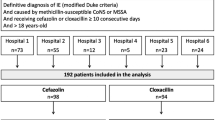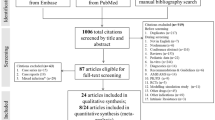Summary
Cefoperazone was evaluated in a multicentre study in the field of internal medicine. The study involved 23 patients with a variety of severe infections including septicaemia, bacterial endocarditis, purulent mediastinitis, orchitis, peritonitis, cholecystitis and salmonellosis. Fourteen of the 23 patients received 2.0 g of cefoperazone i. v. twice daily; the remaining nine patients received a dosage ranging from 2.0 g–12 g daily. Twenty patients showed a favourable clinical outcome and 17 of the 21 from whom pathogens had been isolated showed a satisfactory clinical and bacteriological response. The favourable results obtained in two cases of septicaemia (Staphylococcus aureus andPseudomonas aeruginosa) and two cases of endocarditis (Streptococcus faecalis andStaphylococcus epidermidis) are noteworthy because these conditions are usually difficult to treat. Cefoperazone was well tolerated. There was an increase of platelets or a temporary slight increase in the alkaline serum phosphatase and the transaminases in some patients. These findings indicate that cefoperazone is an effective antimicrobial agent with little or no toxicity. Due to its pharmacokinetic properties and broad antibacterial spectrum, cefoperazone has a valuable therapeutic potential in severe infections or where other antibiotics may cause toxicity.
Zusammenfassung
Zur klinischen Beurteilung von Cefoperazon wurde eine multizentrische Studie durchgeführt, in die 23 Patienten mit verschiedenen schweren Infektionen im internmedizinischen Bereich einbezogen wurden: Septikämie, bakterielle Endokarditis, purulente Mediastinitis, Orchitis, Peritonitis, Cholezystitis und Salmonellose. Von den 23 Patienten erhielten 14 2,0 g Cefoperazon zweimal täglich i. v., bei den übrigen neun lag die Dosis zwischen 2,0 und 12 g täglich. 20 Patienten sprachen klinisch gut auf die Therapie an, und bei 17 von 21 Fällen, in denen die pathogenen Erreger isoliert werden konnten, war ein befriedigender klinischer und bakteriologischer Erfolg festzustellen. Bemerkenswert ist, daß bei zwei Fällen von Septikämie (Staphylococcus aureus undPseudomonas aeruginosa) und zwei Fällen von Endokarditis (Streptococcus faecalis undStaphylococcus epidermidis) ein günstiges Ergebnis erzielt wurde, Erkrankungen, die nur schwer therapierbar sind. Cefoperazon wurde gut vertragen. Bei einigen Patienten stieg die Thrombozytenzahl an, oder es kam zu einer leichten, vorübergehenden Erhöhung der alkalischen Serumphosphatase und der Transaminasen. Aus diesen Befunden läßt sich ableiten, daß Cefoperazon eine wirksame antimikrobielle Substanz ist, die nur geringfügige oder keine Toxizität besitzt. Aufgrund seiner pharmakokinetischen Eigenschaften und seines breiten antibakteriellen Spektrums stellt Cefoperazon ein wertvolles Therapeutikum bei schweren Infektionen oder in Fällen, in denen andere Antibiotika möglicherweise toxisch wirken, dar.
Similar content being viewed by others
Literature
Jones, R. N., Fuchs, P. C., Barry, A. L., Gavan, T. L., Gerlach, E. H., Sommers, H. M. Antimicrobial activity and spectrum of cefoperazone against recent clinical isolates. Clin. Therap. 3 (1980) 14–23.
Kayser, F. H. Microbiological studies on cefoperazone. Clin. Therap. 3 (1980) 24–33.
Shimizu, K. Cefoperazone: absorption, excretion, distribution and metabolism. Clin. Therap. 3 (1980) 60–79.
Craig, A. Single-dose pharmacokinetics of cefoperazone following intravenous administration. Clin. Therap. 3 (1980) 46–49.
Lode, H., Kemmerich, B., Koeppe, P., Belmega, G., Jendroschek, T. Comparative pharmacokinetics of cefoperazone and cefotaxime. Clin. Therap. 3 (1980) 80–88.
Author information
Authors and Affiliations
Rights and permissions
About this article
Cite this article
Bertoye, A., Destaing, F., Dureux, J.B. et al. Clinical evaluation of cefoperazone in internal medicine. Infection 9 (Suppl 1), S50–S53 (1981). https://doi.org/10.1007/BF01641040
Issue Date:
DOI: https://doi.org/10.1007/BF01641040




